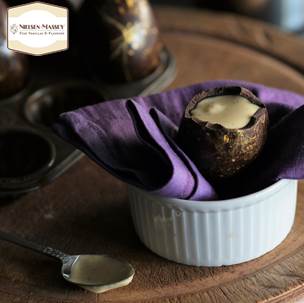
Custard filled Easter Egg

About the bake
Move over crème egg, there is a new Easter egg in town! Master chocolatier, Paul A Young has shared with us his chocolate Easter egg recipe which we have filled with Nielsen-Massey’s deliciously indulgent vanilla custard. This homemade egg would make a great gift for friends and family this Easter.
Ingredients
For paul a young's chocolate egg
- 1kgDark chocolate
For the custard
- 275mlDouble cream
- 1 tbspVanilla bean paste
- 10gBillington's Unrefined Golden Caster Sugar
- 3Egg yolk(s) (free range)
- 1 tspCornflour
Method
Step 1
To make the Easter egg: Place two thirds of the chocolate into a mixing bowl. Position the bowl over a pan of simmering water, on a medium heat. Be careful not to allow the water to boil as this can burn the chocolate and it will become grainy.
Step 2
Allow the chocolate to melt for at least one hour, until the temperature reaches 55°C. Once fully melted remove the bowl from the sauce pan and place on a towel or cloth.
Step 3
Whilst mixing vigorously, add the remaining one third of chocolate to the bowl in small pieces. Keep mixing until fully melted and until the chocolate cools to 27-28°C, this is when the chocolate begins to crystallise.
Step 4
At this point place the bowl back onto the heat until the temperature reached 31-32°C, the chocolate is now ready to use.
Step 5
To test that the chocolate is tempered, dip the end of a knife into the chocolate and allow to set. If the chocolate is smooth, glossy and brittle it is ready.
Step 6
To mould your eggs, use an Easter egg mould made from thick plastic, Silicone moulds won’t be as effective as they can be flimsy and unstable.
Step 7
Clean your mould thoroughly inside with cotton wool until clean and shiny, then pour your tempered chocolate inside to fill the mould fully. Tap on the surface to release any air bubbles that may be trapped in the chocolate.
Step 8
Tip the mould then upside down over a bowl and tap to release any excess chocolate. This will then create a layer of chocolate. Position the mould upside down onto silicon paper and leave for 5 minutes. Repeat this process until you have the thickness of egg you require.
Step 9
Refrigerate for 15 minutes until the chocolate is set before removing the egg from the mould being careful not to touch the outer surface of the egg. Place the egg to one side whilst you make the custard.
Step 10
To make the custard; heat the cream in a saucepan over a medium heat until it reaches boiling point.
Step 11
In a separate bowl, beat together the caster sugar, vanilla bean paste, egg yolks and cornflour until light and fluffy.
Step 12
Carefully pour half of the warmed cream with the egg mixture and blend together.
Step 13
Add the egg mixture back into the saucepan with the remaining cream and heat gently for 1-2 minutes, continuously stirring until the custard begins to thicken.
Step 14
Once thickened, allow the custard to cool and then chill in the fridge.
Step 15
Whilst the custard is chilling, seal together the two halves of the Easter egg, by piping a small amount of melted chocolate around one edge of the egg and carefully stick the other half on top.
Step 16
After 10 minutes the egg should be set fully, create a small hole at the top of the egg, large enough to fit the tip of a piping bag.
Step 17
Fill a piping bag with the custard and insert inside the egg, filling the custard almost to the top.
Step 18
Seal the hole with a small amount of chocolate and allow to set before decorating and packaging in decorative cellophane.
Step 19
Enjoy your egg as soon as possible but always within two days and store in the fridge.
